Jeez internet look at the time I am super sorry this is so late. I’ve been wasting time and money at Anime Boston all weekend, so I am embarrassingly behind on my cartoons – but that all ends RIGHT NOW. Kill la Kill’s been kind of a narrative mess in this second half, but last episode made a very intelligent choice that did a lot of work to address that – it gave Mako her awesome uniform back, meaning I don’t give a shit if KLK even has an ending at all. Last episode was the “everybody finally loves each other” fanservice-fest – this episode’s likely to be the “EVERYBODY’S A BADASS” one.
I don’t use the word “fanservice” in a necessarily pejorative sense, by the way. Normally it is a bad thing – I generally define fanservice as something added to please a certain audience demographic that either doesn’t aid or directly works against the show’s other goals. Which is why voyeuristic nudity is fanservice in a show that generally wants you to respect its characters as people, or why long shots of mechs are fanservice in a show that’s actually also trying to tell a well-paced story. Most people tend to define fanservice as sexy stuff in general, but I find that a far less useful definition – some shows actually do make great, purposeful use of sexuality (cough Monogatari cough), and I think limiting fanservice to sexual content kind of obscures the reason fanservice is considered bad storytelling in the first place.
But with Kill la Kill? The purpose is fanservice – what Kill la Kill is best at is pleasing the fans. It’s pure spectacle, and always at its best when it’s letting its visual aesthetic, sense of humor, and solid direction just go wild. I quite frankly don’t think Kill la Kill is a very good story, but I do think it’s a very distinctive spectacle, and Kill la Kill’s most impressive moments are often also its most indulgent ones.
So go nuts, Kill la Kill. Get stupid, get funny, get big. Do what you do best.
Episode 23
0:08 – Oh, we’re going big, all right
0:18 – DON’T QUESTION IT SHE IS SAVING THIS ANIME
0:32 – Mako being OP is now canon. I guess Trigger really are just doing whatever the internet wants
Poor Mako brain
0:43 – Lovely composition here. The use of color is great – Kill la Kill obviously uses opposing contrasts constantly (starting with the reversed color palettes of Senketsu and Junketsu), and here the small contrast of Inumuta’s blue helps to highlight how much this is Iori’s big moment. It’s like how a whale looks bigger with a human beside it for scale
1:22 – Gamagoori’s looking particularly humongous today
1:27 – The titles guy is just drunk at this point
1:31 – Man, this color work. My posts may seem a bit negative because I’m more of a story guy, but this show’s visual design is undoubtedly its redemption. Color and shadow are always used so well
1:37 – Nui’s been waiting all series to show off her crazy faces
3:31 – Oshit scissor secrets revealed
3:59 – Last episode, when they decided this was apparently her character arc
4:22 – These flying suits are extremely silly-looking
4:30 – This at least was sort of a thing. It would have worked much better if Ryuuko had actually been able to choose her own representation, as opposed to just learning to accept Senketsu, but it still works as an in-story arc. It’s a shame, though – with a few better choices, this show actually could have made some general statements on representation, identity, or sexuality. But I guess that’s just not what this show is, and I shouldn’t blame it for not being Utena
4:53 – More fun shots. All sorts of nice symmetries in this one, in both color and line. Kill la Kill works damn hard to make up for its lack of animation
5:10 – “The beginning and end of all things can be found right here in the original Life Fiber.” Man, Kill la Kill sure likes to screw with me. Lines like this seem totally laden with meaning, but every episode just throws out different ones that cast out threads in completely different directions. Virtually any interpretation of this series could probably find support in an episode or two, but a consistent read? Nah, Kill la Kill just likes to say stuff that sounds cool
Which is fine, of course. It’s just kinda funny to me because my posts always prompt comments to the effect of “you’re totally missing it – this is the entire point of the series,” and they do have evidence… but so do all the other people offering other evidence for other entire points of the series
5:15 – That’s more like it
6:00 – More fun with colors
6:05 – This sequence is great
6:43 – MEANWHILE
7:00 – Can’t handle all this Mako
7:20 – Love this expression. Sensei doesn’t get to show off his obvious Coach roots too often, but this here’s a great one
8:15 – Never too serious for random Mako jokes
8:43 – She’s doing her god damn best
9:08 – Always ready for the spotlight.
9:25 – This show is so friggin’ in love with itself
9:51 – Yeah, they’re great. I particularly like how Nonon actually got a magical girl transformation this time
10:18 – Clearly you haven’t been paying attention. Performance is power, dude
10:53 – Damn, that’s a great shot. One awesome image can be better than an entire poorly directed fight
11:04 – Aw shit she said it
12:07 – Oh no, not Ryuuko! Do you have any idea how painful this will be for Mako?! HEARTLESS
12:19 – It’s okay Mako, you’re the protagonist now
12:58 – She knows them, she just would never admit them. Man, did they actually kill Ryuuko? I really don’t trust this show to kill a popular character, and she seems far too critical to its overall narrative arc to lose, but that’d be pretty damn interesting
13:36 – OF COURSE! Nice little beat for Satsuki’s character to have her accept such a secondary role. But again, that’s pretty much who Satsuki’s been all along – pride is great, but she prioritizes results
13:53 – And she finally gets to do the Satsuki Stomp
13:59 – Wait, we’re getting punished for monologuing, now? What kind of shounen is this?!
14:07 – It’s very appropriate that when the villains in this show start losing, they end up sacrificing the performance that defines their usual power. And it also works nicely in contrast to Ryuuko, who tends to be as direct as possible and had to learn to control her emotions. In response to Ryuuko planning and orchestrating a plan that required anactual performance from her, Ragyo ends up “pulling a Ryuuko” and going into a blind rage. That’s both legit growth and a nice thematic parallel
14:13 – And now Satsuki’s being defended by her family. Nice little narrative tying-offs all over the place here
14:44 – Nice echo of his “I assume you were holding back” all those episodes ago
15:14 – Things gettin’ weird over on the ship
15:39 – Of course the ship transforms. You expected anything less?
17:02 – Mako forever
17:31 – Great shot. A very Gurren Lagann moment
19:02 – Oh boy. Is she actually a giant now, or does she just give even fewer fucks about 2D perspective than usual?
19:33 – Ragyo just cannot stop molesting
20:45 – Always time for more bonding with the Elite Four
22:16 – One more great shot
22:58 – Oh shit. Not even EDs are safe from Nui’s fourth wall-breaking
24:10 – WELP
And Done
Nice! Another solid episode in what’s turning out to be a very respectable last act. Tons of beautiful shots, some really great animation, a suitably ridiculous battle, and actually a good deal of smart symmetry in the resolution of the sisters’ arcs. I didn’t find this week’s battle with Ragyo quite as interesting or exciting as some of the previous fights have been, but there were still plenty of great individual moments, and I think bringing Nui in next week will solve that – Nui’s just a lot more fun than Ragyo. I’m very ready to see every single goddamn thing explode.

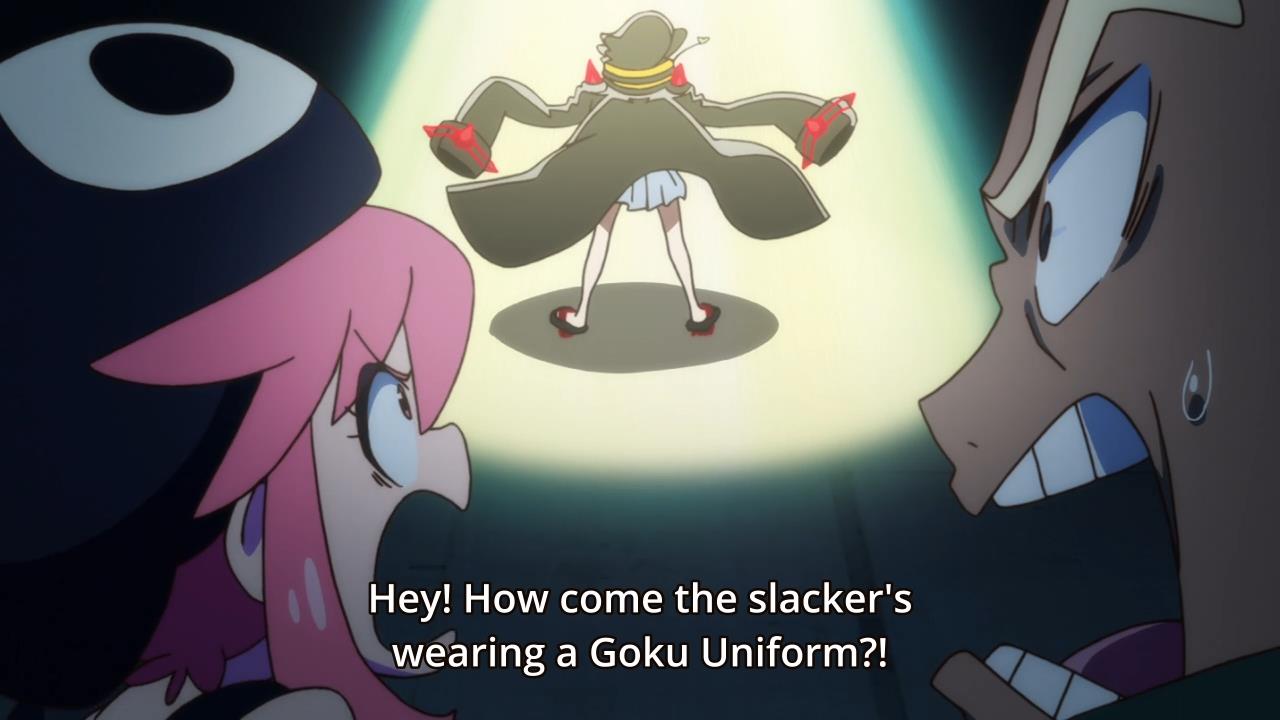
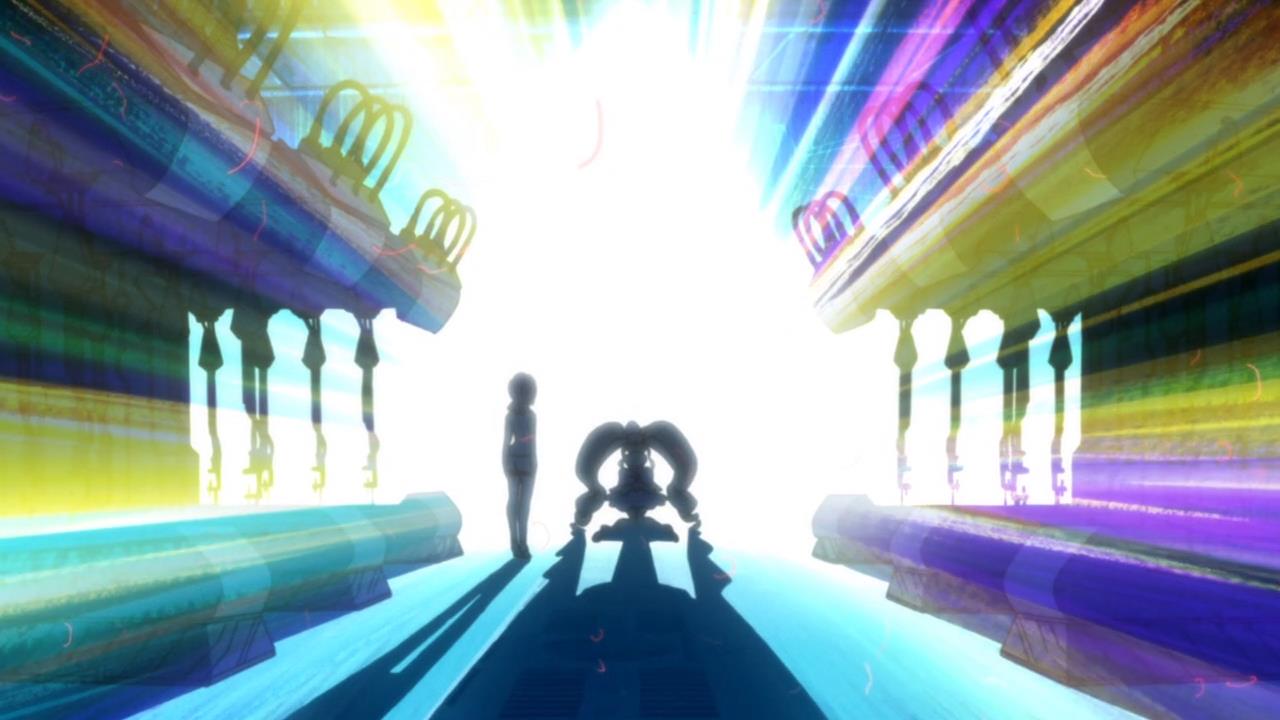
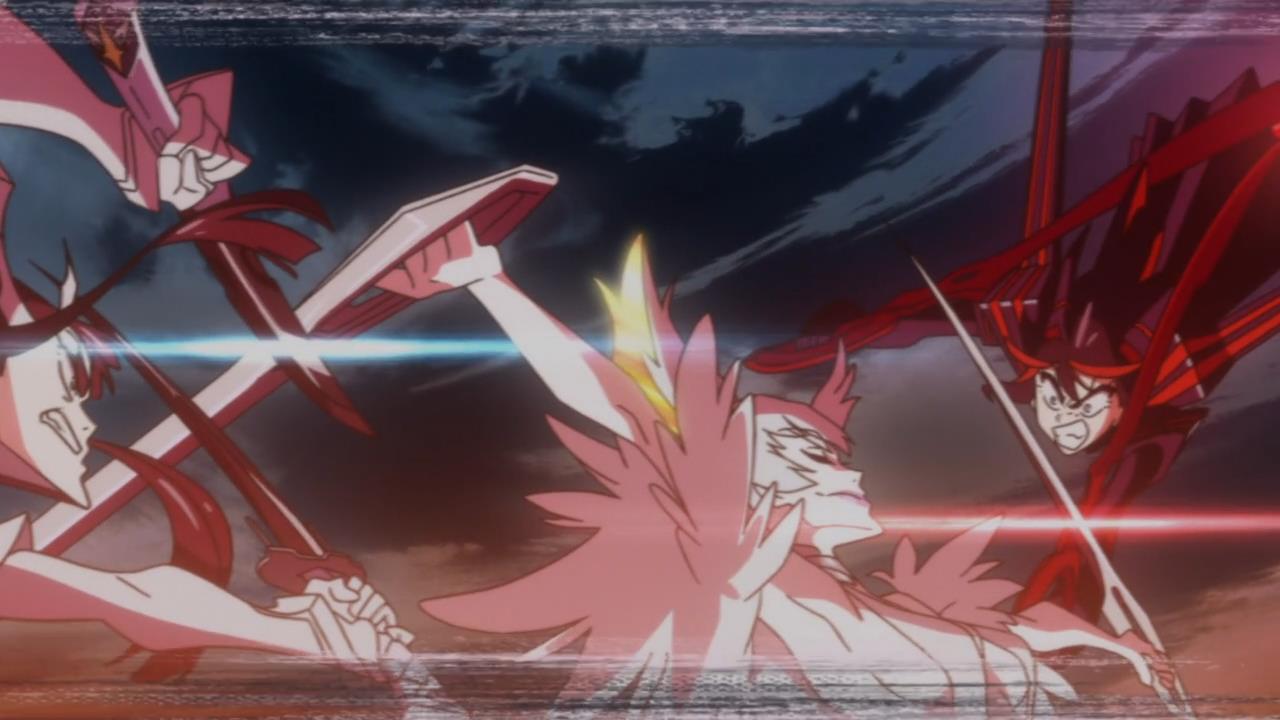
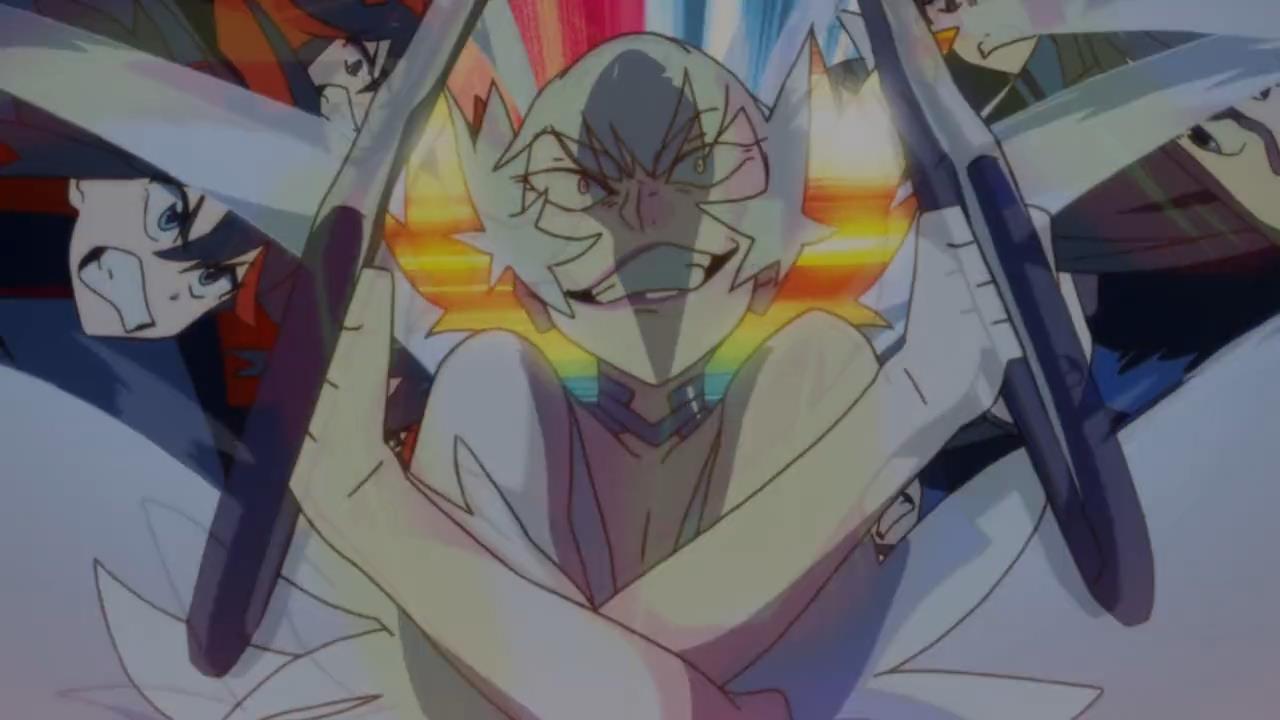
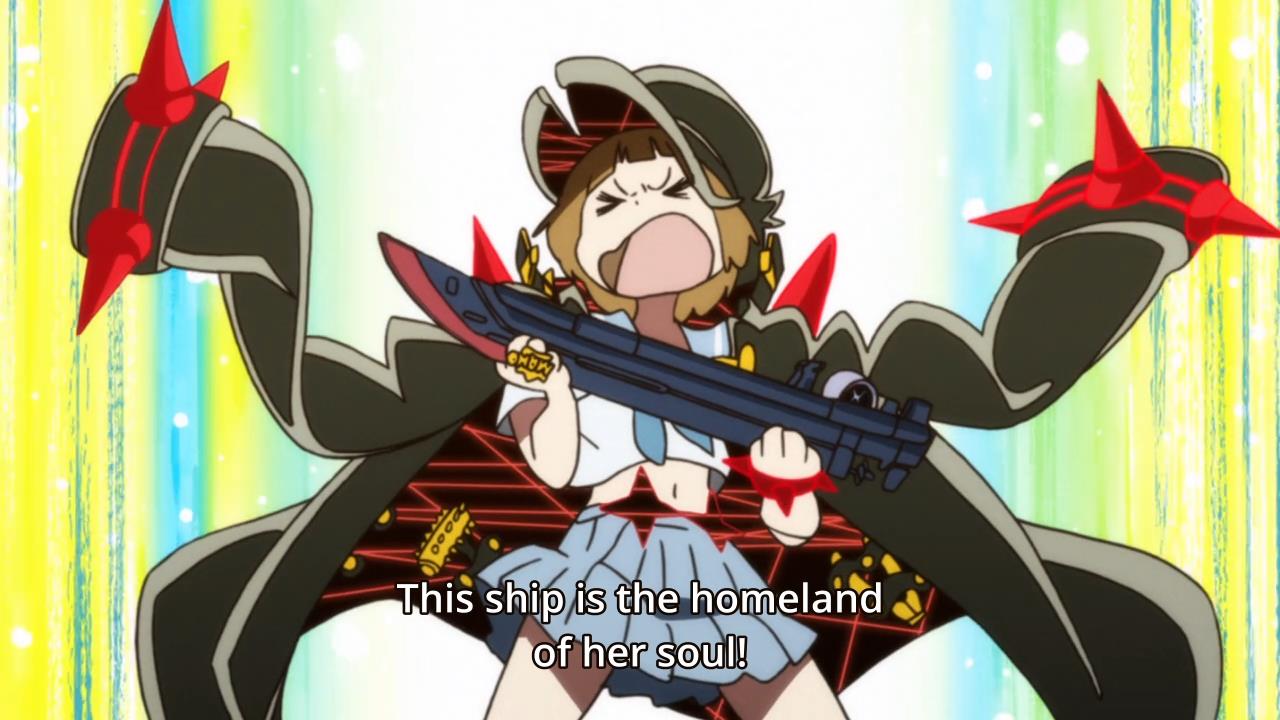
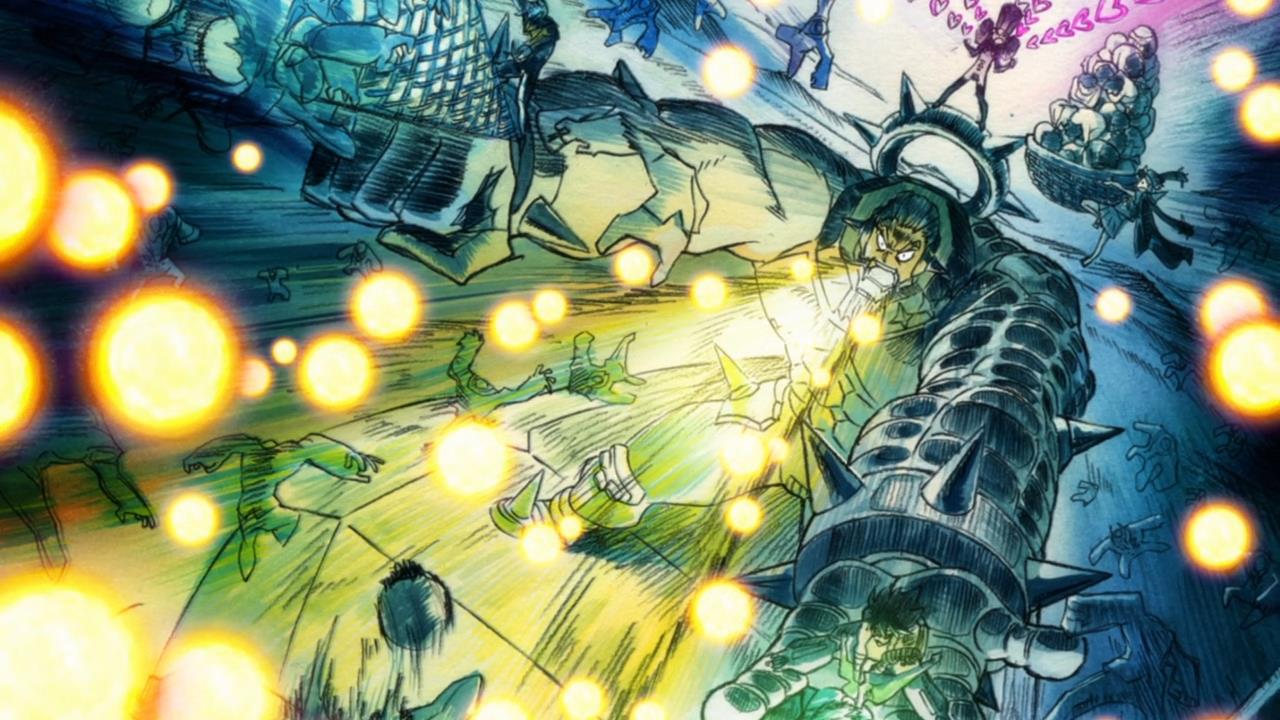
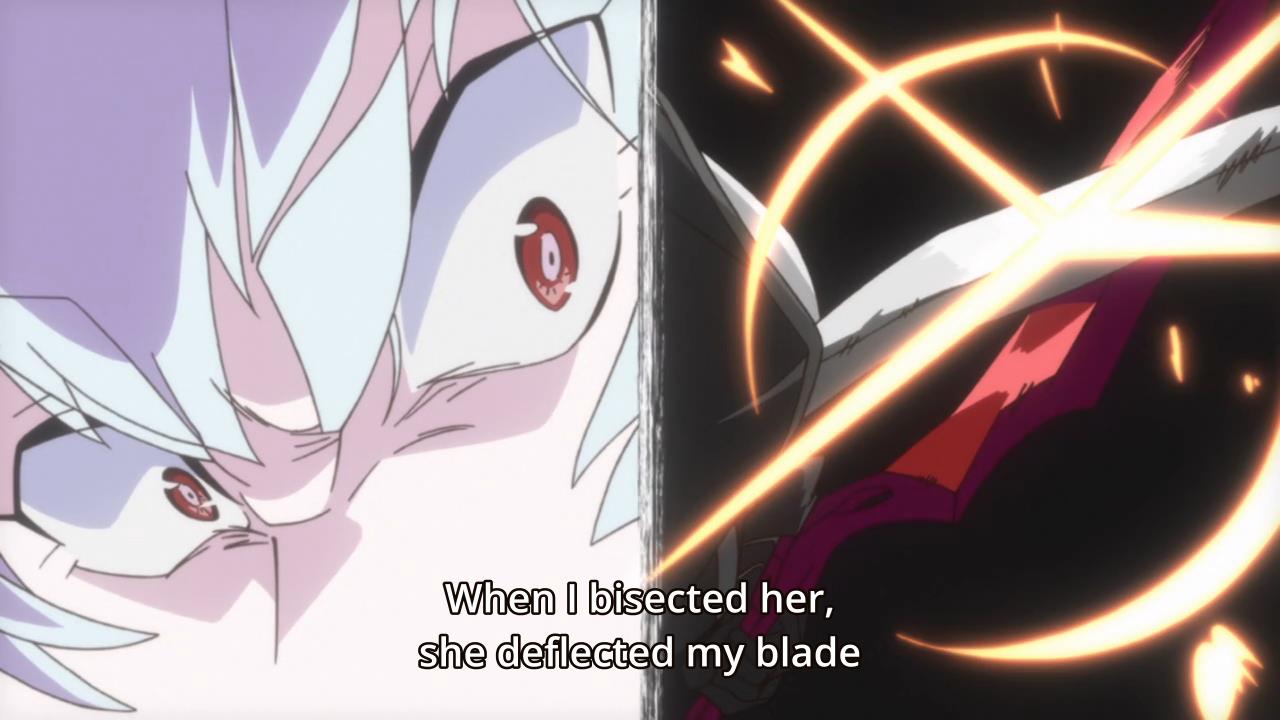
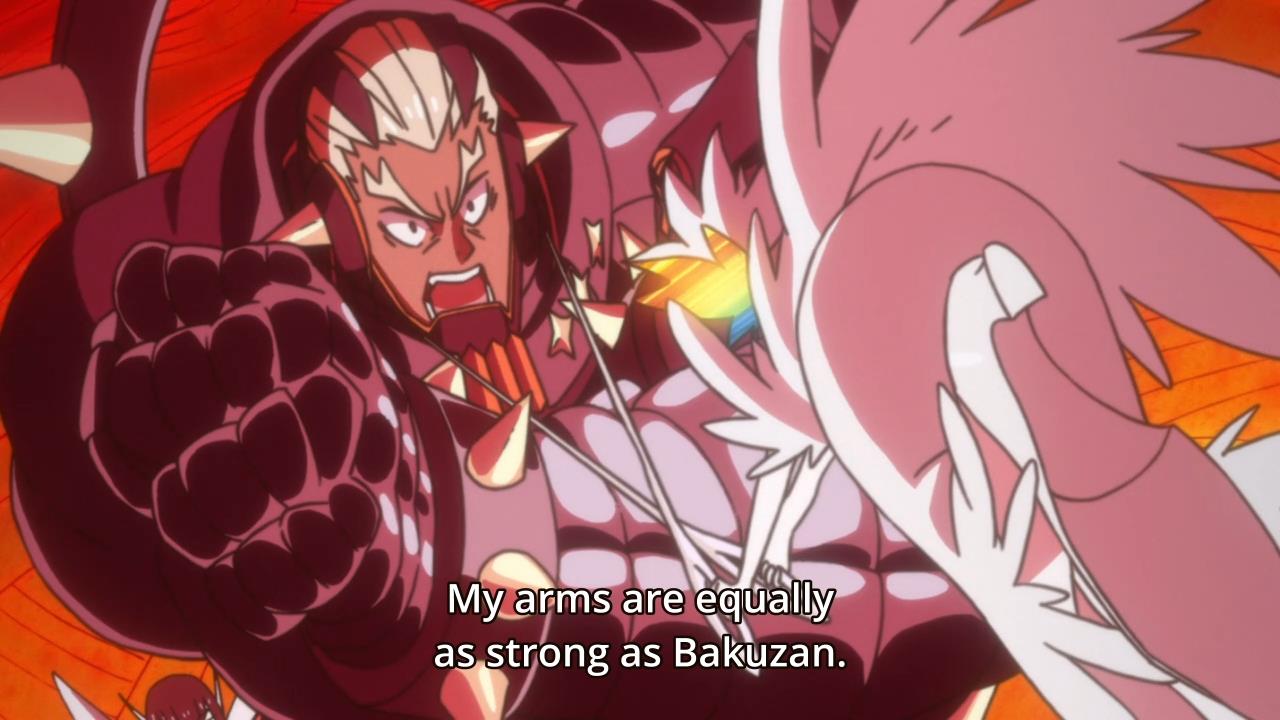
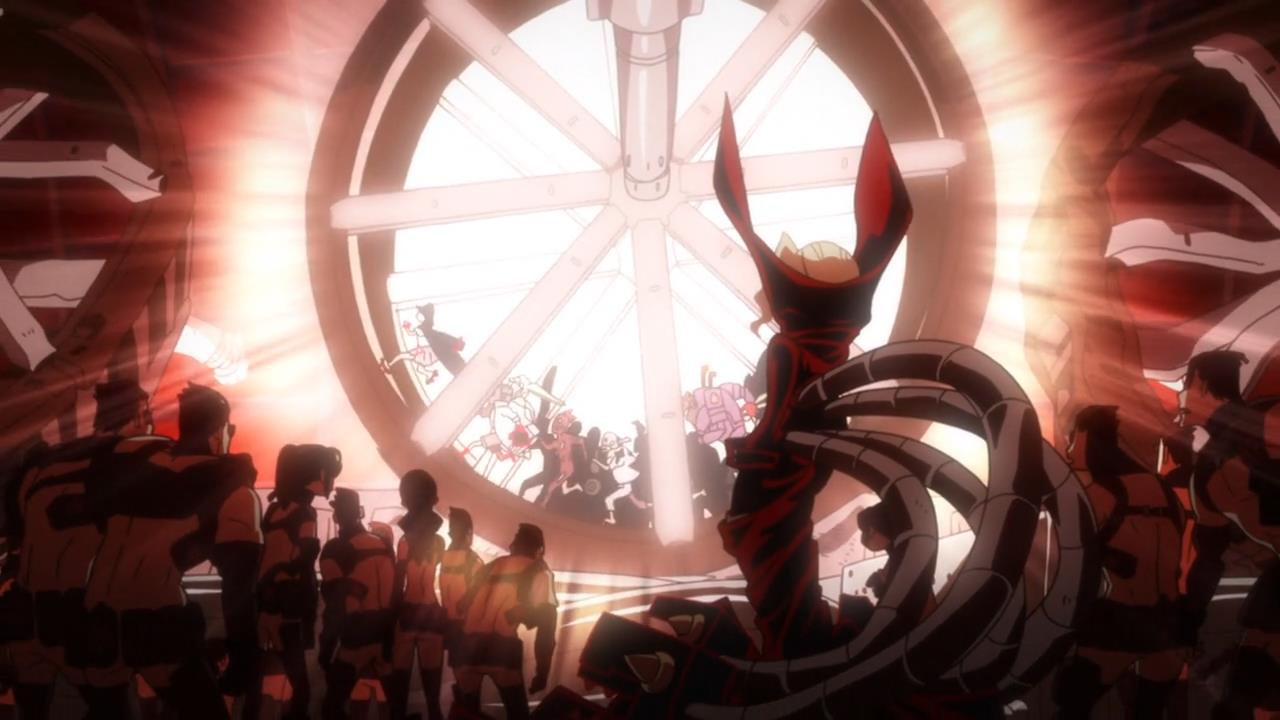
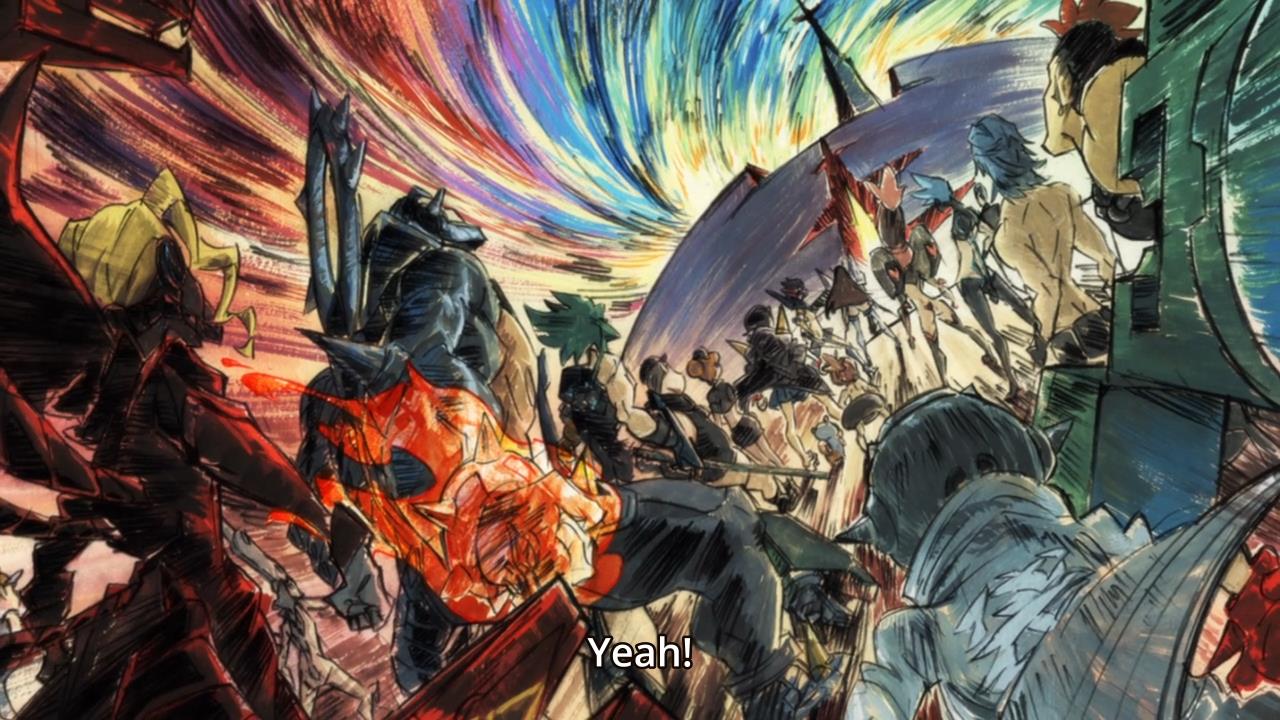
12:19 Another sweet Gamako moment here with Gamagori putting Mako’s hat back on while she unknowingly kinda hugs him.
With this episode having the most blatant Gurren Lagann nods (Ryuko might as well have been shouting “Kick reason to the curb!”), I can totally see the finale going all out and using the two halves of the Great Naked Dagger as a giant makeshift scissor.
That… seems incredibly likely, actually. It still seems impossible the school won’t turn into a giant robot/life fiber.
I feel like watching this show with a group of friends would be a blast, given the right mindset. It certainly has tons of ‘OH SHIT” moments that would lead to a lot of hilarity. Kinda like JoJo in a way.
Not much to say about this one honestly. Just Kill la Kill being Kill la Kill, which means it was a ton of fun to watch. I did really like the new Elite Four Uniforms though, especially how they had a bit of Nudist Beach in them. Also I got so used to blind Sanageyama that seeing his eyes feels wrong. He was cooler with the blindfold.
Agreed, it’s definitely a great group show. I was actually watching a lot of the episodes with my housemates, back when they really were getting posted to Crunchyroll on Thursdays.
Ow yeah! The show´s style never have faltered nor deceived our expectations regarding grandiosity. The only thing, I deem this Big Eldrich Life Fiber too lame, I mean, we were anticipating its final entrance from quite a lot ago, what kind of movement it was going to make, or how it was planning on destroying earth or whatever. Then they go and do this? Just piercing its heart? core, whatever. Wow, don´t even knew it has that kind of weakness, and then that thing just fell over the place (who is going to clean it all?). I´m really hoping that is not the last thing we know about it, because that would be far too deceiving. Merging with Ragyo, entering into the earth core, whatever is better than lying dead in the middle of the streets there! Also, it was kind of silly for Ragyo to be floating around over that nasty flashy thing for two or three episodes, silly and funny. Let´s hope that final confrontation with superpowered Ragyo can be a good one, not like this…
Enjoyed the episode, but it didn’t have the kind of visceral adrenaline inducing power that last episode have. I thought it lacked tension: never for a moment was convinced that Ryuko was dead and the Original Life Fiber died off way too quickly for all the build up.
It really is all about Ragyo, which is interesting, because it sort of frames the whole show as more of a family drama than a cosmic battle for the survival of humanity, much like how World Conquest is more about the personal relationships necessary to conquer the world than about the actual conquering itself.
THE reason why I love kill la kil is its fantastic aesthetic presentation and direction. It’s so freaking good and on point man. But everytime I mention it people don’t seem to understand what I’m talking about. I get: ”wtf man the characters are sliding around and shit it sux, newground animators do better”. But they don’t get that when there is sliding its so thoughtfully done depending on the mood it want to convey and so freaking dynamic, and goddamn these characters poses and that framing are glorious ALL THE TIME. It’s masters at work, freaking perfect on that point despite the budget.
So yea thanks for addressing on here.
I also agree on the meh story structure.
“Virtually any interpretation of this series could probably find support in an episode or two, but a consistent read? Nah, Kill la Kill just likes to say stuff that sounds cool
Which is fine, of course. It’s just kinda funny to me because my posts always prompt comments to the effect of “you’re totally missing it – this is the entire point of the series,” and they do have evidence… but so do all the other people offering other evidence for other entire points of the series.”
I also wonder whether what happens is actually that the writer just think “cool stuff” or that they actually DO come up with a certain symbolic interpretation, and then two episodes later come up with a different one and just decide that’s better and they’re going to go along with that one. Personally I feel like Trigger’s motto is probably that great, GREAT quote from Panty & Stocking: “You’re always joking around! Are you never serious?” “We’re ALWAYS serious – we’re seriously joking around!”. That’s it, Kill la Kill is seriously joking around for me. Kinda like Panty used to do with men, it flirts with a theme or another for a while, then ditches it because it can’t be constrained by it – the only thing that matters is having fun.
I personally like to think as you said that they do have meaning for what they say it just doesn’t add up to a coherent message. Feels it use that structure because it’s mostly played out for style for the most part which is fine considering what klk is.
You say that the Monogatari series makes great, purposeful use of sexuality. While I agree on this point regarding some characters, I personally find its sexualization of the child characters (including Shinobu, who is really 700 years old or something but amounts to the youngest, most sexualized child in the show) reprehensible to the point of distraction much more than anything in Kill La Kill. I know that you’re a much more avowed fan of the series than I am and would like to hear your take. I’ve only seen up to Nisemonogatari myself.
Nisemonogatari was actually the first show I talked about on the internet!
https://wrongeverytime.com/2013/04/14/nisemonogatari-and-the-nature-of-fanservice/
You say that the Monogatari series makes great, purposeful use of sexuality. While I agree on this point regarding some characters, I personally find its sexualization of the child characters (including Shinobu, who is really 700 years old or something but amounts to the youngest, most sexualized child in the show) reprehensible to the point of distraction much more than anything in Kill La Kill.
That’s interesting. We have pretty opposite views on the fanservice in Kill La Kill versus the fanservice in Nisemonogatari. Again, I like the series, but I am very uncomfortable with its positioning of children as sexual beings by a male creator for the consumption of a male audience, no matter how much “control” they seem to be given by the camera. I can’t get over the fact that no matter how much the narrative stresses their power or messes with their positioning they’re still acting this way for a male figure within and outside of the narrative. I also disagree with your statement that the Shinobu bath scene isn’t eroticized – the shots tend to emphasize her chest and she later propositions Araragi. This scene and the Karen toothbrush scene felt like degradations of characters that I previously really liked – Karen became another person, albeit of her “own will,” on order to engage in coded sex with her brother when anime like Revolutionary Girl Utena had already discussed how nasty and prevalent that particular strain of thinking is.
I do think that Kill La Kill isn’t trying to do anything as interesting as the Monogatari series regarding fanservice, but it’s also not doing anything as reprehensible. They’re interesting shows to compare for the reactions they’ve garnered on various corners of the internet.
“The connection between the characters is honest, and the way the show is conveying their emotions to the audience is honest as well – intimacy is really just another word for honesty. This honesty, which makes this scene so strong, is a part of why most fanservice is so bad – because it’s dishonest to the characters, and portrays them as sexual objects when they’re not actually feeling like sexual objects in that moment. But more than that, this honesty is almost entirely lacking in conventional pornography. Conventional pornography is generally a collection of soul-deadened actors performing a service for a fee – sure, they’re naked, but it’s the furthest thing from intimacy you could possibly imagine. To find someone disrobe emotionally, you have to look to art. And so the point of this scene is “Even in a scene as ridiculous as this, honesty can make it ring true.”
I actually strongly, strongly disagree with this. What I feel you’re describing here isn’t emotional honesty, but emotional pornography. The emotional intimacy revealed at this moment is still entirely for the benefit of the male character and spectator. As a woman, there was nothing honest to me about this scene. In fact, this was the point where I stopped being able to identify with Karen. Very few women would derive pleasure from having sex with their brothers in any situation – the power dynamics are too strong for this subject to be treated so lightly, no matter how much Karen jokingly flirts with Araragi. Intimacy needs to be reciprocal and genuine, and this scene did not feel genuine because I cannot fathom why the previously strong and well-characterized Karen would suddenly desire this, which no woman – or really, in her case, girl – desires. A big part of being a good character writer is making it seem as though the characters are making choices when they and their actions are really a collection of choices on the part of the author, and the toothbrush scene broke the illusion and showed me that they had no intention of treating Karen well, that they would subsume her illusory will at a moment’s notice to feminize her and make her want to have sex (albeit coded sex) with her brother, who is privileged by the narrative due to his sex despite being a less interesting character. I view this as the compartmentalization and fetishization of women’s personalities above their bodies and much more harmful and insidious than just showing their boobs.
I guess we just disagree on the purposefulness and value of the framing, then? Frankly, up until Nekomonogatari/Monogatari S2, I don’t think the Monogatari series has the best character writing – I see its best work as its visual experimentation, which I somewhat divorce from Isin’s often transparently authorial-voice-dominated writing. You can’t really escape the intended audience of a work, but I think the show’s choices are valuable because they demonstrate interesting things about sexuality in visual storytelling, and offer what I consider a strident proof of concept for this kind of stuff.
In contrast, I don’t find Kill la Kill’s choices meaningful, and so I just see it as objectification with no greater purpose – or worse, objectification that almost unintentionally subverts the very importance of these subjects by claiming its characters DO possess agency when they really don’t. I find “these choices don’t matter” more frustrating than a legitimate attempt to engage with the relevance of these choices that may come off as exploitative.
But yeah, if you don’t believe in the character emotions as they’re being framed, none of the other stuff will probably matter/work. That’s fair.
Incidentally, I’d also recommend sticking with it a bit longer. I think the series gets much, much better as it goes along, and that Season 2 is basically where it comes into its own as a coherent narrative. Everything before that I see more as a series of interesting and creative but flawed experiments.
It’s also ironic that when you condemned the incestuous rape motif in Kill La Kill when Nisemonogatari presents an incestuous (again, coded) relationship between older brother and younger sister positively and with much more erotic detail, especially when the act is preceded by a feminization of the little sister to present her vulnerability.
(I’ll be honest, your essay peeved me, but it also intrigued me, and I’d like to engage about it.)
It’s not the incest part I have a problem with!
Incidentally, I’m not a huge fan of all of Monogatari’s choices myself. Some of its scenes just straight-up are smutty fanservice, Araragi is clearly a totally gross person, and almost every scene with Mayoi makes me wince. But I do think it has a lot else going on.
Oh yeah I do like the show overall despite my strong negative opinion on the fanservice and want to stick with it. I’m optimistic about Monogatari S2. The only reason I haven’t seen it so far is time.
Two cents here! I haven’t seen Monogatari (dropped after the grand total of one episode as I found it a tad bit too pretentious and faux in dialogue and use of fanservice – namely, it bored me) but about Kill la Kill and objectification… I read something very interesting some time ago in an article: we talk about objectification when we see sexual fanservice in anime, but really, what we seem to disregard is that these women ARE objects – they’re drawings. So it’s not the objectification that makes the operation work, but the personification, namely the fact that the writers (with the help of the viewer) try to make these fictional women as real-sounding as possible. No one (well, almost no one) lusts after an inanimate object. And very few would lust after a simple drawing without a voice, a character, a story behind it. So in my opinion the worst fanservice is not the one that shows the higher amount of naked skin, because that’s not even real skin, and let’s be honest, if you’re willing to, you can find as many pics of as many women as much naked as you want them on the internet. The worst fanservice is the one that sells a CHARACTER: that entertains the fantasies of the viewer by creating a fictional woman who not only can be ogled, but that also feels accessible, “easy” – or even worse, “asking for it” (and that happens way too often in anime). So that’s why the fanservice in Kill la Kill never bothered me. It’s pure visual entertainment; it shows naked flesh as much as it shows blood, but is we never argue that the second should turn us all murderers, why should the first one make us rapists? I see it rather as part of the general hot-blooded, vital drive of the show. And even when there IS rape, and is portrayed in a negative light, it doesn’t really sell Satsuki as a submissive character. Because she’s just enduring it. And two episodes later, she stabs in the back, impales and decapitates the fucker. Yup, try getting off to THAT thought while you hug your Satsuki body-pillow, random otaku.
(Similar considerations apply to P&SwG, where Panty’s rather disinhibited sexuality didn’t make her look more appealing or accessible, instead it made her intimidating and she was often hated on for being a “slut”)
The “selling a submissive fantasy” is basically just another kind of sexism, and I agree, that’s really bad. But that being another relevant problem doesn’t really invalidate the issues with objectifying characters and media soaked in the male gaze. It still dehumanizes characters meant to signify people (I find the “it’s only drawings” argument to basically just be nonsense, by the way – in fiction, we’re always talking in terms of signifiers, but our attitudes towards these signifiers reflect and shape our actual attitudes). It still tacitly encourages perspectives that minimize people’s ability to control their own representation, something which is a far more open and relevant societal debate than murder being wrong. It still strongly declares a work as “for” a given audience, isolating those represented by the characters it’s objectifying.
Characters using their sexuality as a weapon is awesome. Characters being forced to dress in revealing outfits because of narrative contrivances while the camera leers at them is less awesome.
While I understand your point about signifiers, I didn’t mean simply “since they’re drawings it doesn’t matter”; rather, that, since they’re drawings, the signifier acquires a different meaning depending on its context and the way in which it is presented, because all those elements concur in making it take the shape of something resembling a “person” in the viewer’s mind. Or in other words, while having an actual woman pointlessly dressed in skimpy clothing on TV is probably to some extent humiliating to a real person, no matter what the purpose is, having an anime character in the same clothing is something I can take more lightly because it only has importance in terms of message (this made me think of a rather horrible story I read involving Marlon Brando and a scene of anal sex in “Last tango in Paris”, a movie that now, no matter how good it can be from a cinematographic point of view, I will never be able to watch without feeling utterly disgusted).
Going to the issue of the “male gaze”… well, yes, again, to an extent. I don’t think there’s anything wrong with showing nudity by itself, even with a sexual purpose. And Kill la Kill plays a lot with nudity, both male and female, with a rather light-hearted attitude. I don’t think that, taken by itself (in a void, so to say) the show is doing anything to offend anyone specifically. But as it is often said, shows don’t exist in a void. In context, I can understand that the idea of female nudity being exposed is more sensitive – but it is so only because of what others do. It’s like having two movies who don’t pass the Bechdel test – but one is a story of a lot of male and female coworkers in a city and the other is about a company of soldiers in army that doesn’t even admit women. Clearly they both contribute to a negative statistic, but the first one is more at fault than the second. Here the same applies to me. Kill la Kill isn’t especially progressive, true, but it isn’t a serious offender either. Trying too hard to be correct is what leads to stuff like “token strong female characters” that becomes an obnoxious (and sexist) trope by itself. And while it’s ok to be worried about media that truly enforce bad stereotypes (we know about how the submissive fantasy thing IS having an actual effect on Japanese society, to the point of being identified as one of the reasons of a general disconnect between men and women), it’s also true that a bit of artistic license can and should be allowed, and that’s where people’s judgement applies – because ultimately, if I draw my own ethics and behaviour from subtle influences received by anime, it’s still mainly MY responsibility.
I also think, connecting back to the issues with Japanese society and especially with the anime fandom, that in that context something like Kill la Kill is doing could be read differently, less like an iteration of the typical male gaze and more like a willing subversion of the usual way of doing fanservice, by claiming the stage for a form of sexual enjoyment that has more to do with anarchic fun and less with contrived formal relationships of power and shame, but I guess this is something that only someone knowing Japan from the inside could truly state.
Well, yeah. That’s what I’m saying is the problem. I don’t care that some drawings of women are being humiliated for little narrative purpose, I care about the worldview that choice propagates. And storytelling-wise, I care that the show is telling me these characters don’t deserve respect, because that disconnects me from them as people I should be invested in.
Disagreed on this one. Characters of both genders may get naked, but while Sensei gets to make jokes about stripping, the camera really leers at Ryuuko and Satsuki. This show is clearly shot with a male audience in mind.
This just kinda sounds like a soft version of “media doesn’t influence culture,” which I strongly disagree with. Obviously few people take their entire worldview from any given media object, but it all adds up, which is why we need to talk about this stuff.
If I thought the show actually supported this read, I’d be all for considering it – but I just don’t think the show has much to say about this. I think it just does what feels good, which ironically means “doing what feels good” isn’t really a coherent theme in it.
A soft version of “media doesn’t influence culture” would be “media influence culture and behaviour to a point“, which seems reasonable enough to me. It is something that deserves talking about of course, but it’s not the be-all and end-all of the issue. We can represent stuff that we deem reprehensible and refrain from actually putting that stuff in act in our lives. It is, in a different form, the same argument about video games nurturing violence or rather being cathartic with respect to it. I think both answers in this field have their arguments – we know that GTA IV didn’t transform our youth in a crowd of murderous thugs, but it’s also naive to assume that it doesn’t do anything to subtly influence its players’ world view. So the problem is: is showing female nudity for no purpose but titillation not the highest form of art and entertainment, and does it belong to a male-dominated culture? Yes. Is it contributing to maintain the status quo? Sort of, as every other product of that culture does in different measures, as the cultural status quo is by definition self-preserving. Is it going to have actual effects on someone’s behaviour towards women? Well, it could, in theory, influence a tiny percentage of its viewers. But this influence will be sparse and different, filtered by each viewer’s interpretation of the show. For example, I never paid much attention to the nudity as I was more caught by the action, and so did many. Someone has even found a (likely not intended by the author) female empowering reading of the show, and will draw a different message out of it. For me, heaving heard some comparisons between this show and Utena has pushed me to finally watch that one, so I actually earned a better awareness of an interesting discussion around gender roles as a secondary consequence of this show. The message is not as clear cut and obviously negative as it is in shows that indulge, say, in rape apologetics (ahem ImoCho ahem). There are as many readings as viewers, and I think it’s demeaning to people to attribute too much power to media. Or at least, to a single work of media – there is a matter of general mold, of course, but in that sense, Kill la Kill is a minority contribution to our Hollywood-dominated culture; it should be compared with the average of other anime and Japanese media and with respect to the condition of women in Japan, not judged by our western criteria.
I think that’s the general reading of the show mostly taking into account also Imaishi’s work in Panty & Stocking – where “doing what feels good” was also an explicit theme, in fact. Of course, this IS done from a male perspective – it is inevitable when it comes to sexual matters that one ends up indulging in his own point of view, and if anything, in a perfectly symmetric world, a different show with different authors should provide us with the opposite one. Ultimately, I don’t think the Trigger people is thinking this through too much – after all, planning and trying to send a message (no matter whether it is pro- or counter-culture) is not a very anarchic thing to do. I think that, yeah, the show is trying to do what “feels good”, but also that this is its own message, in a medium and a society that seems way more constrained by formal rules than what we’re used to. Considering the extents to which anime seems to suggest that female nudity is something to be oogled through fingers while giggling for boys, and to be absolutely hidden with great prejudice and shame for girls, isn’t saying “just get naked and don’t give a shit about it” a subversive message in itself?
Hey! I don’t mean to intrude especially since I haven’t seen Monogatari yet, but I think you (Gabbo Gabbo) might be commiting a little fallacy here: “why the previously strong and well-characterized Karen would suddenly desire this, which no woman – or really, in her case, girl – desires”.
Just because you’re a woman that doesn’t mean you can know or possibly even imagine what every other in the woman would desire in those circumstances. To put this into perspective, I am a male who happens to have a baby sister, and I genuinely can’t imagine how people come to develop sexual attraction for their siblings. But I know it’s believable and that it actually does happen, and even more, that the people to whom it happens are human beings who are as complex as you and I–therefore I know an incestous male character can be both a realistic and a with-depth character.
But like I said, I haven’t actually seen the series. I just wanted you to consider this possibility (that you are overextending your own self as what “a woman” (usually) is), because Bodbuh’s points seem pretty strong to me.
Gabbo showed me this comment, and I was so…shocked I had to reply.
First of all, just this: “I just wanted you to consider this possibility (that you are overextending your own self as what ‘a woman’ (usually) is” ….do you realize how incredibly condescending and insulting this comes across when you say that you’re a man? How could you know what a “woman’s perspective” is or be in a place to lecture women about that?
Secondly, Gabbo is right about incest: in real life, it nearly always involves complicated consent issues, if not being outright non-consensual. The number of people – of any gender identity – who freely consent to and freely want it, who show agency in desiring incest, is statistically insignificant, I would say. That’s why the romanticization of it in anime (among other stuff) is so disturbing. And why it feels like a female character’s strength is being taken away, or at least, distorted, when the story suddenly has her want that in order for it to feel sexy. And it makes her less realistic, because – again – no people realistically “freely choose” this. It’s possible, as a hypothetical, but the fact that that is hypothetical takes away from the realism and makes it seem like characters are closer to male-fantasy ideas of women than actual women. Which alienates female viewers, wanting women who feel realistic to them.
Hell, it’s a good argument in favor of the idea that “agency” is not the be-all end-all of what makes a good female character, as I’ve seen the Internet argue as of late. It’s really easy for an author to make a female character “desire” things that line up with traditional gender roles or, in this case, male fantasy ideas of what women want, and that doesn’t do diddly-squat to promote the agency of real women. If anything, it diminishes it, by telling women who don’t want these things “but some women do, so we don’t have to listen to you!” (Which is essentially what you’re saying to Gabbo’s comment.)
Gabbo’s perspective as a woman is absolutely valuable because what she’s saying is that women have an at-least-slightly better idea of what they want out of media in terms of their representation than men do. And she’s arguing that Kill la Kill is something she finds better at that than stuff like Monogatari, since she finds the female character’s desire more realistic and them overall treated more respectfully by the story. I haven’t seen Monogatari personally either, but as another woman who watches KLK, I agree with her that that series has issues but is ultimately doing a lot of things right… which is why it seems to have found a larger female following than a lot of “fanservice shows”. The female characters are multi-faceted and realistic, and their desires don’t bend to the rules of what men want.
I haven’t seen KLK yet, so perhaps this comment should be made in the Nisemonogatari comment section instead, but a few thoughts:
1) Monogatari S2 existing makes a world of difference, because for the most part, it’s about exploring the world from non-Araragi perspectives, so the fanservice and camera-leering is cut down so much, as said other non-Araragi perspectives aren’t such blatant perverts, and so showing that the overall intention of the show isn’t about the sexual tropes. Some quotes from one of Bobduh’s episode write-ups: (Out of context and thus fairly spoiler-free, imo)
“SohumB proposed the idea that [the narrator of this arc]’s about as close to an author avatar as we could get – Isin himself coming in and saying “look, this isn’t sexy. You’re all really weird. Stop doing that.” You all know my thoughts on this series – it wouldn’t surprise me if this were the creators just throwing up their hands and admitting the audience won’t realize the character perspectives aren’t aligned with the show perspective unless someone comes along to directly tell the characters they’re acting like children”
“Reminder: this [Nadeko] is the same character who was essentially “fanservice-violated” in the first season. She is now laughing and playing with blocks. Because she is a child.
It’s like Anno with his Rebuilds. “Wait, they still don’t get that it’s satire? Fuck subtlety, we’re nuking otaku culture from orbit””
2) From my interpretation of the show, Monogatari is both sincere in its perversity and playing Poe’s Law at the same time. Isin seems to acknowledge how problematic sexual elements in anime are these days, and somewhat highlights them through a combination of taking them up to 11 to highlight their ridiculous aspects, and by having every character call out how ridiculous they are. One of the elements that sets Araragi apart from your standard harem protagonist is his self-awareness of the sexual tropes in him and around him, and how he comes off to other people for it. Over the course of Bakemonogatari his commentary on such things becomes less and less deprecating, until by Nekomonogatari, he’s become fully shameless. (As a result of getting with Senjougahara and becoming friends with Kanbaru?) One of my favorite parts of Nisemonogatari was anything with Kanbaru in it.
However, like many anime consumers, Isin still genuinely enjoys the tropes, even while he knows that they’re problematic. He’s admitted that Nisemonogatari was written as self-service, which is why there’s less of an effort at characterization than in S2, or even S1, and feels more like a celebration of the tropes where Bakemonogatari always called them out. It’s a little like Peter Jackson and his roots in splatter film.
Furthermore, Isin is a troll, so he writes ambiguous-intention sexual scenes which can be consumed as straight-forward fanservice or interpreted as a satire of it, and he gets the bonus entertainment of people puzzling and arguing over which type it is.
Shinbo is even more so than Isin. He seems to intrinsically understand the appeal of sexual fanservice, but also understands how ridiculous it is. I really couldn’t tell if the absolutely terrible and disgusting Sasami-san@Gambaranai was going for Poe’s Law or not. While Bobduh considered the Karen crotch shot in episode 2 of Nisemonogatari as neutral, I wasn’t so sure, and thought that Shinbo probably stuck that shot in there as a jab at the audience. The toothbrush scene comes off as a culmination of Isin and Shinbo laughing at how the the “fuck you, and thanks for the cash” aimed at the people consuming it as straightforward fanservice was going to whiz over their heads, as is most of the sexualization of the girls in Monogatari. “Your fetish is silly, I shall stuff you with it.” Except that the “fuck you” is blurred because Isin and Shinbo can and do also enjoy straightforward sexual fanservice.
The Mayoi wordplay conversation in episode 1 of Nisemonogatari is another one of my favorite scenes of the season, and Araragi getting pied in the face gets me every time, but it also demonstrates how Monogatari mocks and loves sexual fanservice at the same time. He is pied because he is a pervert and deserves it, (mocking) but its comedic nature as an ejaculation joke renders the punishment into a reward, asking the audience, “Can you really blame the man? Mayoi panties are just that sexy.” (loving)
I can’t speak for Karen’s characterization being bastardized for the sake of the toothbrush scene, because Karen and Tsukihi never felt like real characters to me to begin with. While all of Monogatari’s girls are, from Araragi’s perspective, varying degrees of Manic Pixie Dream Girl, the Fire Sisters pretty much exist to prod at Araragi’s characterization and to provide fanservice, sexual or comedic. (The supremely random “Yuri Sisters” moment at the end of Karen Bee pulling double duty) There was opportunity for some development when they mentioned how Tsukihi doesn’t believe in Justice, and is in it for Karen’s sake, but we never see the two sisters discuss or act on this difference, so it’s just another avenue for Isin to add to the “nisemono” theme, than anything that makes them more than plot devices. So with them, anything goes. There’s no characterization to break, because we’ve only ever been told, not shown, the ways they work, by an unreliable narrator.
Finally, there’s always the argument over if having more artistic value outweighs being more problematic as well, than a less problematic work that also has less redeeming values.
(My personal eternal hang-up over anime has been over if shows’ artistic merit or potentially progressive elements can be outweighed by an audience’s use of Death of the Author to promote problematic elements instead, which Bobduh briefly touched on in his Rebuild essay. Hypothetically, if the ultimate impact of Madoka Magica is to sell more sexualized magical girl merch, then does the reality of its strengths, perhaps not ignored in the consumption of the anime, but exerting no influence over the toxic actions and mindsets of its consumers, make up for it? Anyone can make a positive interpretation of a work, but if its practical effect is the propagation of the negative interpretation, the latter can’t be ignored in its evaluation.)
sailortralfamadore, the reply system here is a bit strange but I hope you (and Gabbo, of course) get to see this.
I didn’t mean to sound condescending at all; which is precisely why I put the equivalent example of people of my own gender. I have absolutely no idea what the sexuality of thousands upon thousands of men is. I wouldn’t ever talk for the male demographic because though there may be patterns in the end each gender is about 50% of the world population, which means a number of INDIVIDUALS so high I’d feel downright ridiculous saying anything is something “which no man desires”.
I mean, I don’t consider gender to be anything aside from a biological fact having no genuine bearing on personality (which is what Gabbo was speaking about i.e. fetishization of PERSONALITIES (which she is absolutely right in that it is way more harmful than just showing boobs)) aside from a few patterns more common in one gender than the other, which would surely attenuate almost completely without the preconcieved notions of “feminity” and “masculinity”; you might be interested in hearing that I own skirts. I kind of wish I hadn’t mentioned my gender just so no one would dwell on that.
Nonetheless, I think it boils down to the fact that -I haven’t seen what they’re addressing-. And like I just said in parenthesis, I agree that the fetishizing of women’s personality (in fact, any fetishizing associating gender with personality, which as you’ve likely realized I have a strong distaste for) is WAY more harmful than common fan service. It’s a horrible society we live in where say, male characters are written to yearn being kings while female ones are usually associated with “princess” (and if that wasn’t enough, queens are usually the evil ones).
For now I offer a sincere apology. Obviously Gabbo’s opinion is much more valuable than mine both because of her gender and because SHE HAS SEEN WHAT THEY’RE TALKING ABOUT. I’m very sorry. And like you, I hope for a world where writers aren’t asking “how do we write an interesting female character?” instead of realizing it’s basically the same as writing an interesting male–which is to say, writing an interesting PERSON.
Pingback: Bristle’s Babble’s #2 – Kill la Kill (2013-14) (SPOILERS) | Bristle's Babbles